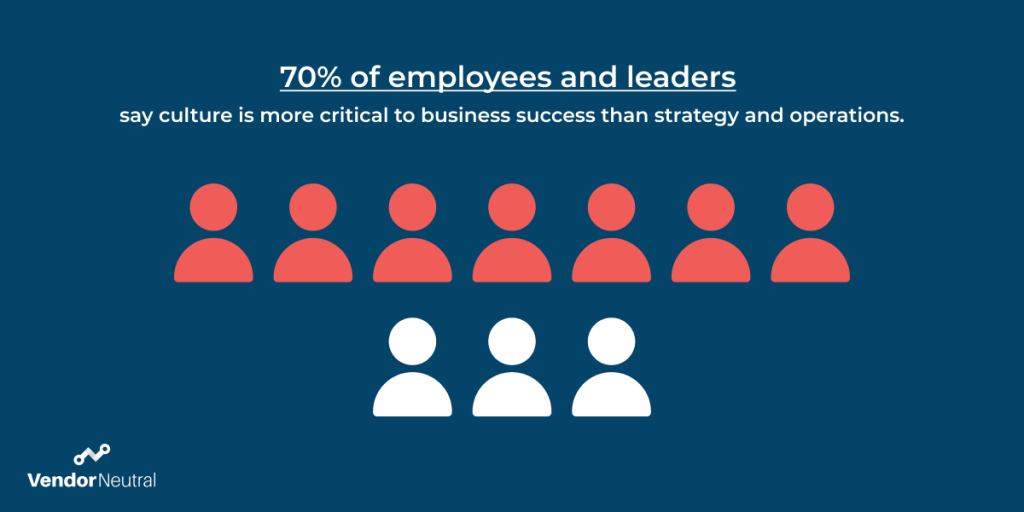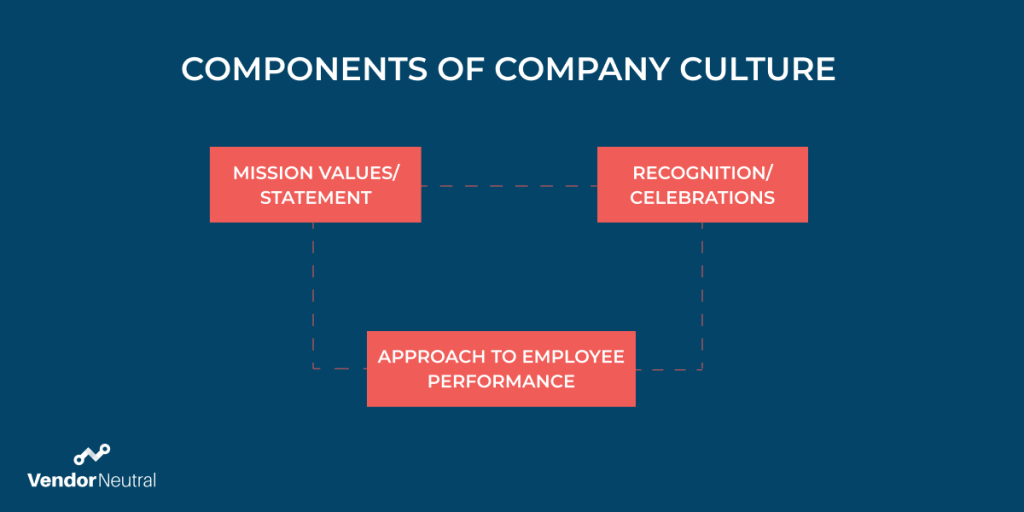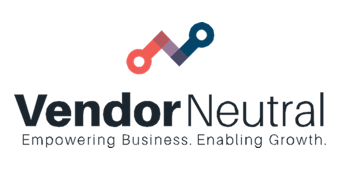How Company Culture Drives Sales Tech Stack Impact and Adoption

How company culture drives sales tech stack impact and adoption
Culture is the heart around which the lifeblood of the company courses.
Research by Deloitte has shown that 94% of executives believe a distinct corporate culture is essential to a business’ success and almost 70% of employees and leaders say culture is more critical to business success than strategy and operations.
Culture is the heart around which the lifeblood of the company courses.
How a company defines itself and wishes to be viewed by its employees, peers, customers and clients is more than a mission statement, branding or marketing around these values: it’s authenticity around ethos – and actions.
It determines an organization’s ability to retain engaged and productive employees who constantly move the needle for their customers – and their CEO’s bottom line.
Culture powers teams, people and business excellence: read on for why a positive company culture is core to successful sales tech stack adoption, sales tech impact … and how to develop a robust one.

Culture allows Sales Tech Stack adoption
McKinsey reports that 70 % of change programs fail to achieve their goals, largely due to employee resistance.
If 70% of digital transformations fail, the myth that sales tech alone can solve organizational issues or improve your bottom line has undoubtedly been debunked.
While there are many additional reasons why a sales tech stack might fail to be adopted, underutilized, or create the impact the CFO desires, 62% of organizations cite culture as the biggest hurdle to digital transformation.
As Josh Paul explained on our recent Sales Tech and Innovation Hub webinar: adoption is 20% tech and 80% people and processes… culture.
If, as Gartner reports, only 34% of change initiatives are ‘clear successes’, understanding why organizational ecosystems are resistant to change and adaptation – and how you can cultivate yours to improve the likelihood of success – is vital as you consider implementing new sales tech, strategy, or digital transformation.
"62% of organizations cite culture as the biggest hurdle to digital transformation."

Creating Company Culture
All companies have culture. But not all cultures are equal.
IBM’s founding chairman Thomas J. Watson Sr. is credited as the first business leader to intentionally develop a company culture: workers aligned around a standard set of values and goals.
In 1914, IBM had recently merged three companies in disparate parts of the US. Watson understood that for the business to survive, to succeed, the three would have to work together, not just operationally, but with a shared ethos.
Authors Tom Peters and Robert H. Waterman Jr. in ‘In Search of Excellence’ explain the importance of company culture: “What makes it live at these companies is a plethora of structural devices, systems, styles, and values, all reinforcing one another so that the companies are truly unusual in their ability to achieve extraordinary results through ordinary people.”
Culture is the connections between people that make a company a community, as Peters and Waterman Jr. suggest.
Done well, company culture makes going to work in the morning a pleasure – and dealing with the business equally so. Done badly, it creates absenteeism, and stress and, ultimately, risks the business’ survival.
Before you consider implementing new sales technology, question what your company culture looks like and if it’s ready to adapt to the digital or sales tech stack changes you see as necessary.
Questions on Culture
A healthy culture is a key to excellence. So, how do you describe your company culture? Or, more importantly, how do your employees?
If you have yet to survey your employees on this, you’re perhaps missing out on essential data on their perceptions of culture.
Simple adjectives are telling – and a gauge of what your teams are experiencing in their working life.
Disengaged employees typically use words like ‘demanding’, ‘disorganized’, ‘stressful’, ‘professional’ to describe their company culture.
According to Quantum Workplace, the top 10 ways employees describe their ideal company culture are:
- Flexible
- Inclusive
- Supportive
- Caring
- Collaborative
- Fun
- Engaging
- Innovative
- Diverse
- Positive
This is the language you want to see in employee feedback. These are signifiers of a healthy company culture that is robust enough to evolve with your growth and sales tech innovation.
But what are the aspects of your organization that affect culture?
Components of Company Culture
Whether building, improving, or maintaining your company culture, you’re working not on (just) on how you meet, office operations, or ‘how we do things around here’, but on transparent and articulated attitudes and behaviors that are not just embedded but amplified throughout your company.
When asked what aspects of their workplace they experienced their organizational culture most powerfully, the top three results were in this 2022 survey were:
- Mission values/statement
- Recognition/celebrations
- Approach to employee performance
Only 28% of employees experience culture through the physical environment.
A healthy culture is palpable in the elements of your business most do not see: in how you celebrate, challenge, support, talk, and what you value and ask your employees to.
And despite job title, role, tenure or position, from CEO to office junior, culture must be constant: a top-down and bottom-up approach.

Cultural Community
Leaders and managers must enact their organization’s culture in all of their actions. Inauthentic statements about a company’s values will quickly become evident if employees don’t see them being lived out by their CEO.
As only 54% of employees feel connected to their company’s purpose compared to 77% of senior management, the C-Suite must communicate their organization’s core values and mission often: making them ever visible in the workplace.
Crucially, culture cannot be delegated.
It can be celebrated, reiterated, and monitored, but each person in the organization must work to uphold it.
Tony Hsieh, the former CEO of Zappos, took it further famously stating that: “If employees are bad for our culture, we’ll fire them for that reason alone.”
Hsieh linked great culture with great performance: “Our whole belief is that if you get the culture right, most of the other stuff like delivering great customer service or building a long-term enduring brand will just happen naturally on its own.”
The correlation seemed to bear out: Zappos was on Fortune’s ‘Best Companies to work for‘ for six years straight, while increasing sales year on year and being routinely acknowledged as giving stellar customer service.
Culture Changes
Culture is also not fixed: its evolution is natural and vital. Each employee should shape and help grow the company’s culture as much as they help increase its revenue.
Take Hubspot.
A company with 73,400 customers and more than 3,800 employees, in 2018, decided to live by its values of transparent company culture and publish a 128 page internal document: the HubSpot Culture Code slide deck.
Rather than see their culture as ‘job done’, they’re also proud of its many iterations. Like HubSpot, they say, the Culture Code is a perpetual “work in progress”. To date, they’ve updated it more than 25 times.
Culture is the ecosystem that supports strategy and process – and, most importantly, their change… and the evolution or addition of digital tools.
'Culture eats strategy for breakfast.'
A healthy company culture is the foundation of your business.
The famous quote ‘Culture eats strategy for breakfast’ reiterates that strategy and goal-setting are irrelevant without this core stability. Long-term growth and increased revenue cannot be achieved in an organization with a weak or even toxic culture.
- A healthy culture improves employee retention. Disengaged employees are 2.8x more likely to leave their company due to poor culture than engaged employees: “People do not just quit companies or leaders … they quit organizational cultures.”
- Engaged employees are more connected to their teams and the organization and are more productive. Employees who say their culture is positive are 3.8x more likely to be engaged.
A robust company culture helps align teams and recruit new members who believe in the mission – and that they can add value to the collective effort to achieve it.
Integration, partnership, and alignment: these are the tenants of a healthy culture that can drive sales tech stack implementation with impact and ROI.
The Conditions for Digital Transformation
Even with the above alignments, digital transformation requires a culture that accepts risks, accepts failure – and is adaptive enough to fail fast, together, and forward.
The reality is that the constant evolution of the digital world means that digital transformation is never complete: creating a culture that is adaptive and agile enough for consistent change and tolerant of risk is vital.
If you’re looking for insight into how your company culture is affecting your ability to create impact with your sales technology or digital transformation, sales tech consultancy is our specialty, and a discovery call might be your best next step.
If you’re ready to procure, our Sales Technology Buying Roadmap will help you buy wisely to progress your next stage of digital evolution.


